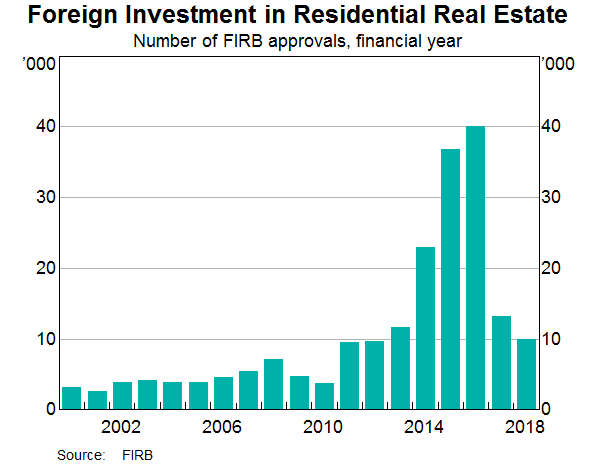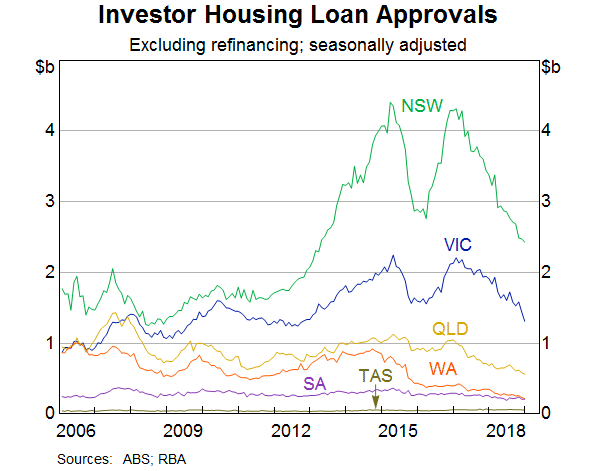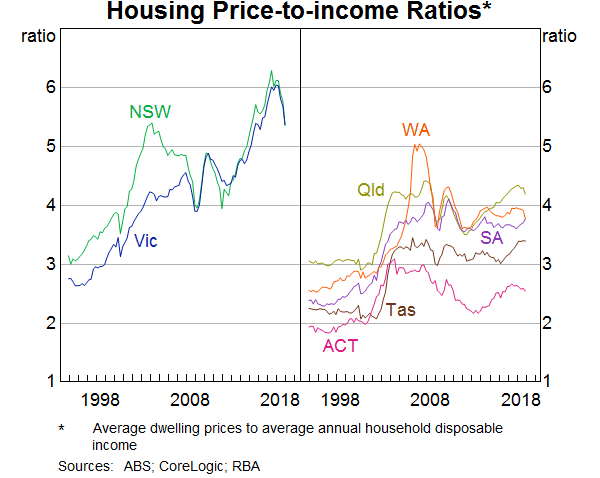If you're wondering who you should believe about the state of our property markets may I suggest you trust RBA Governor Phil Lowe.
The people who run this country must think he's pretty smart because they pay him a pretty penny.
To help you understand his views, below is a speech he recently gave at the AFR Business Summit.
In it Lowe stressed how fragmented our property markets are.
“It is pretty clear that there is no such thing as the Australian housing market. What we have is a series of separate, but interconnected, markets.”
His point is that each city is unique with its own dynamics.
While prices are falling in Sydney, Melbourne, and Perth, other markets don’t look so bad.
He made many other salient points - here is a transcript of part of his speech - it's definitely worth reading...
The Current State of the Housing Market
Australians watch housing markets intensely, perhaps more so than citizens of any other country.
Over the five years to late 2017, they saw nationwide housing prices increase by almost 50 per cent (Graph 1).
Since then, prices have fallen by 9 per cent, bringing them back to their level in mid 2016.
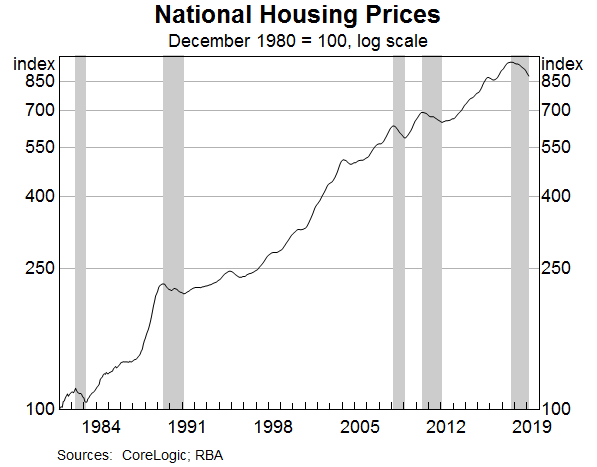
Declines of this magnitude are unusual, but they are not unprecedented.
In 2008 and 2010, prices fell by a similar amount, as they did on two occasions in the 1980s.
In the 1980s, the rate of CPI inflation was higher than it is now, so in inflation-adjusted terms, the declines then were larger than the current one.
These nationwide figures mask considerable variation across the country
The run-up in prices over recent years was most pronounced in Sydney and Melbourne, so it is not surprising that the declines over the past year have also been largest in these two cities.
In Perth and Darwin, the housing markets have been weak for some time, affected by the swings in population and income associated with the mining boom.
By contrast, the housing market in Hobart has been strong recently.
In Adelaide, Brisbane, Canberra and many parts of regional Australia, conditions have been more stable.
Given these contrasting experiences, it is pretty clear that there is no such thing as the Australian housing market.
What we have is a series of separate, but interconnected, markets.
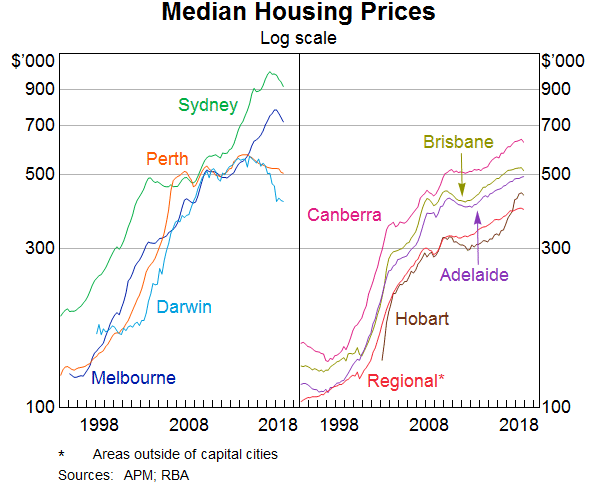
Another important window into housing markets is provided by rental markets.
Over recent times, the nationwide measure of rent inflation has been running at a bit less than 1 per cent, the lowest in three decades.
As with housing prices, there is a lot of variation across the country.
Rents have been falling for four years in Perth and are now around 20 per cent below their previous peak.
By contrast, in Hobart rents have been rising at the fastest rate for some years.
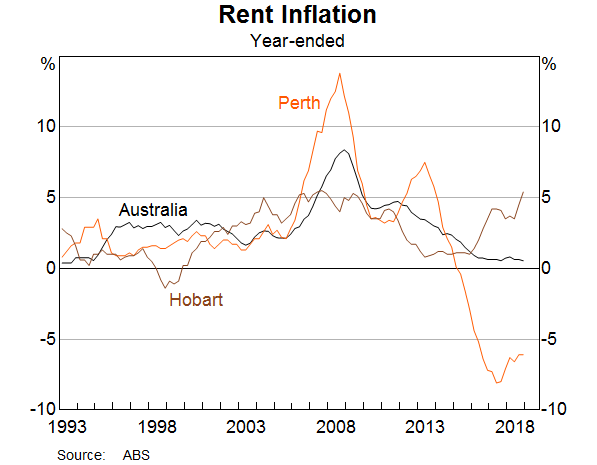
As is well understood, shifts in sentiment play an important role in housing markets.
When prices are rising, people are attracted to the market in the hope of capital gains.
At some point, though, valuations become so stretched that demand tails off and there is a shift in momentum.
When prices are falling, it's the reverse.
The prospect of capital losses leads buyers to stay away or to delay purchasing.
At some point, though, the lower prices draw more buyers into the market.
First home owners find it easier to buy a home, investors are attracted back into the market, and trade-up buyers take the opportunity to upgrade to the home they have always wanted.
These shifts in sentiment and momentum are seen in most housing cycles, but their precise timing is difficult to predict.
Some of these shifts in sentiment are evident in consumer surveys.
Over recent times, the number of people reporting that an investment in real estate is the wisest place for their savings has fallen significantly.
So, it is not surprising that there are fewer investors in the market.
At the same time, the number of people saying it is a good time to buy a home has increased.
Lower prices draw more people in and, eventually, this helps stabilise the market.
So it is worth closely watching these shifts in sentiment.
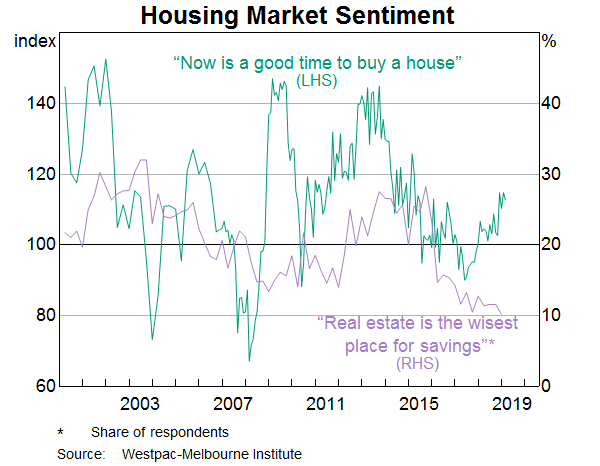
Explaining the Recent Cycle
An obvious question to ask is what are the underlying, or structural, drivers of the large run-up in housing prices and the subsequent decline?
There isn't a single answer to this question. Rather, it is a combination of factors.

Unlike the other four episodes in which housing prices have declined in recent decades, this one was not preceded by rising mortgage rates.
Nor has it been associated with a rise in the national unemployment rate.
Instead, in New South Wales, where the recent decline in housing prices has been the largest, the unemployment rate has continued to trend down.
It is now at levels last seen in the early 1970s.
The unemployment rate has also trended lower in Victoria.
So, the origins of the current correction in prices do not lie in interest rates and unemployment.
Rather, they largely lie in the inflexibility of the supply side of the housing market in response to large shifts in population growth.
It is useful to start with the national picture (Graph 5 below).
Australia's population growth picked up noticeably in the mid 2000s and it took the better part of a decade for the rate of home building to respond.
It took time to plan, to obtain council approvals, to arrange finance and to build the new homes.
Not surprisingly, housing prices went up.
Eventually, though, the supply response did take place.
Over recent times, the number of dwellings in Australia has been increasing at the fastest rate in more than two decades.
Again, not surprisingly, prices have responded to this extra supply.
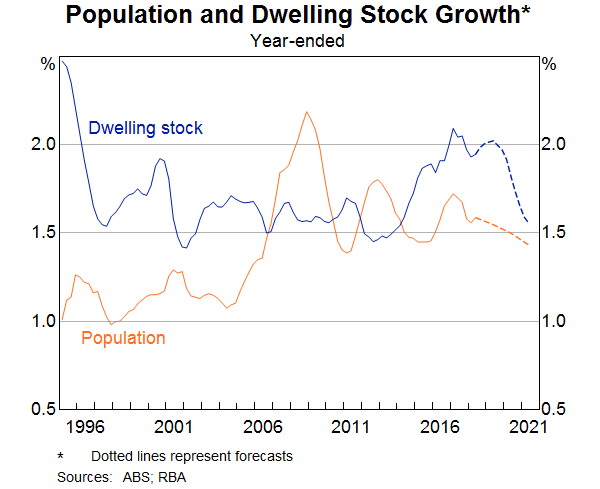
The population and supply dynamics are most evident in Western Australia and New South Wales (Graph 6).
During the mining investment boom, population growth in Western Australia increased from around 1 per cent to 3½ per cent. This was a big change. The rate of home building was slow to respond.
When it did finally respond, it was just at the time that population growth was slowing significantly, as workers moved back east at the end of the boom.
This explains much of the cycle.
In New South Wales it is a similar story, although it is not quite as stark.
The recent rate of home building in New South Wales is the highest in decades.
At the same time, population growth is moderating, partly due to people moving to other cities, attracted by their lower housing prices and rents.
By contrast, in cities where population patterns and the rate of home building have been more stable, prices, too, have been more stable.
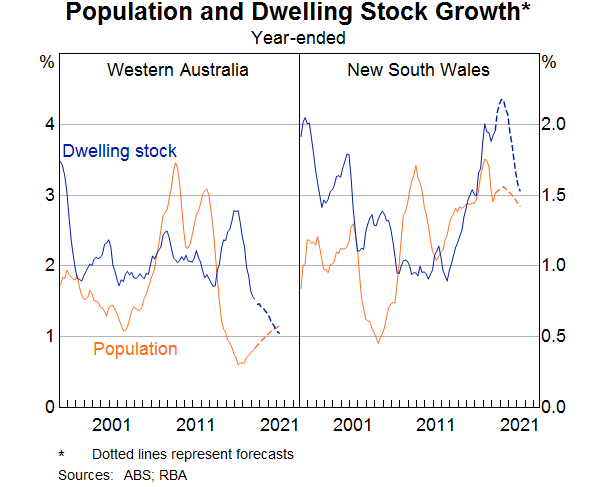
Another demand-side factor that has influenced prices is the rise and then decline in demand by non-residents.
One, albeit imperfect, way of seeing this is the number of approvals by the Foreign Investment Review Board (Graph 7).
In the middle years of this decade, there was a surge in foreign investment in residential property, particularly from China.
This was apparent not just in Australian cities, but also in ‘international’ cities in other countries.
In Australia, the demand was particularly strong in Sydney and Melbourne, given the global profiles of these two cities and their large foreign student populations.
More recently, this source of demand has waned, partly as a result of the increased difficulty of moving money out of China as the authorities manage capital flows.
The timing of these shifts in foreign demand has broadly coincided with – and reinforced – the shifts in domestic demand.
However, making a full assessment of their impact on prices is complicated by the fact that international property developers were also adding to supply in Australia at a time of very strong demand.
More recently, these developers have scaled back their activity.
Domestic investors have also played a significant role in this cycle.
This is especially the case in New South Wales, which was the epicentre of strong investor demand (Graph 8).
At the peak of the boom, approvals to investors in New South Wales accounted for half of approvals nationwide, compared with an average of just 30 per cent over the five years to 2010.
More than 40 per cent of the new dwellings built in New South Wales recently have been apartments, which tend to be more attractive to investors.
The strong demand from investors had its roots in the population dynamics.
Low interest rates and favourable tax treatment added to the attraction of investing in an appreciating asset.
The positive side to this was that the strong demand by investors helped underpin the extra construction activity needed to house the growing population.
But the rigidities on the supply side, coupled with investors' desire to benefit from a rising market in a low interest rate environment, amplified the price increases.
As I discussed earlier, there is an internal dynamic to housing price cycles, and this one is no exception.
By 2017, the ratio of the median home price to income had reached very high levels in Sydney and Melbourne (Graph 9).
Finding the deposit to purchase a home had become beyond the reach of many people, especially first home buyers if they did not have others to help them.
At the same time, the combination of high prices and weak growth in rents meant that rental yields were quite low.
So, naturally, momentum shifted.
Given the big run-up in prices and the large increase in supply, a correction at some point was not surprising, although the precise timing is nearly impossible to predict.
Interest rates
No discussion of housing prices is complete without touching on interest rates and the availability of finance.
The low interest rates over the past decade did increase people's capacity to borrow and made it more attractive to borrow to buy an asset whose price was appreciating.
But the increase in housing prices is not just about low interest rates.
The variation across the different housing markets indicates that city-specific factors have played an important role.
Recently, much attention has also been paid to the availability of credit.
This attention has coincided with a noticeable slowing in housing credit growth, especially to investors (Graph 10).
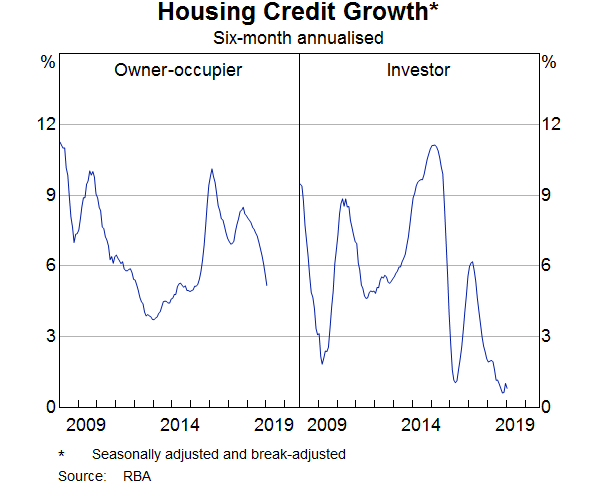
It is clear there has been a progressive tightening in lending standards over recent years.
The RBA's liaison suggests that, on average, the maximum loan size offered to new borrowers has fallen by around 20 per cent since 2015.
This reflects a combination of factors, including more accurate reporting of expenses, larger discounts applied to certain types of income and more comprehensive reporting of other liabilities.
Even so, only around 10 per cent of people borrow the maximum they are offered.
Sensibly, most people borrow less than what they are offered, so the effect of this reduction in borrowing capacity has not been particularly large.
It has also been apparent through our liaison that some lenders became more cautious last year.
There was a heightened concern by some loan officers about the consequences to them and their career prospects of making a loan that might not be repaid if the borrower's circumstances changed.
So, lenders became more risk averse.
This, along with greater verification of expenses and income, led to an increase in average loan approval times, although some lenders have invested in people and technology to address this.
Our liaison suggests that application approval rates are largely unchanged.
Overall, the evidence is that a tightening in credit supply has contributed to the slowdown in credit growth.
The main story, though, is one of reduced demand for credit, rather than reduced supply.
When housing prices are falling, investors are less likely to enter the market and to borrow.
So too are owner-occupiers for a while.
Consistent with this, the number of loan applicants has declined over the past year.
There is also strong competition for borrowers with low credit risk, which is not something you would expect to see if it were mainly a supply story.
This competition is evident in the significant discounts on interest rates on new loans compared with those on outstanding loans.
Even though the slowing in credit growth is largely a demand story, we are watching credit availability closely.
It is perhaps stating the obvious to say that we want lenders who are both prudent and who are prepared to take risk.
As lenders recalibrated their risk controls last year, the balance may have moved too far in some cases.
This meant that credit conditions tightened more than was probably required.
Now, as lenders continue to seek the right balance, we need to remember that it is important that banks are prepared to take credit risk.
And it's important that they have the capacity to manage that risk well.
If they can't do this, then the economy will suffer.
Read more at RBA Speeches









